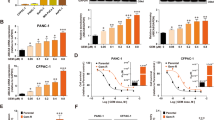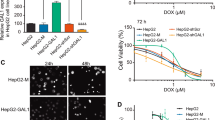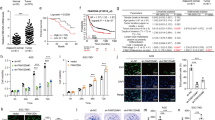Abstract
The fluorinated analog of deoxycytidine, Gemcitabine (Gemzar), is the main chemotherapeutic drug in pancreatic cancer, but survival remains weak mainly because of the high resistance of tumors to the drug. Recent works have shown that the mucin MUC4 may confer an advantage to pancreatic tumor cells by modifying their susceptibility to drugs. However, the cellular mechanism(s) responsible for this MUC4-mediated resistance is unknown. The aim of this work was to identify the cellular mechanisms responsible for gemcitabine resistance linked to MUC4 expression. CAPAN-2 and CAPAN-1 adenocarcinomatous pancreatic cancer (PC) cell lines were used to establish stable MUC4-deficient clones (MUC4-KD) by shRNA interference. Measurement of the IC50 index using tetrazolium salt test indicated that MUC4-deficient cells were more sensitive to gemcitabine. This was correlated with increased Bax/BclXL ratio and apoptotic cell number. Expression of Equilibrative/Concentrative Nucleoside Transporter (hENT1, hCNT1/3), deoxycytidine kinase (dCK), ribonucleotide reductase (RRM1/2) and Multidrug-Resistance Protein (MRP3/4/5) was evaluated by quantitative RT–PCR (qRT–PCR) and western blotting. Alteration of MRP3, MRP4, hCNT1 and hCNT3 expression was observed in MUC4-KD cells, but only hCNT1 alteration was correlated to MUC4 expression and sensitivity to gemcitabine. Decreased activation of MAPK, JNK and NF-κB pathways was observed in MUC4-deficient cells, in which the NF-κB pathway was found to have an important role in both sensitivity to gemcitabine and hCNT1 regulation. Finally, and in accordance with our in vitro data, we found that MUC4 expression was conversely correlated to that of hCNT1 in tissues from patients with pancreatic adenocarcinoma. This work describes a new mechanism of PC cell resistance to gemcitabine, in which the MUC4 mucin negatively regulates the hCNT1 transporter expression via the NF-κB pathway. Altogether, these data point out to MUC4 and hCNT1 as potential targets to ameliorate the response of pancreatic tumors to gemcitabine treatment.
This is a preview of subscription content, access via your institution
Access options
Subscribe to this journal
Receive 50 print issues and online access
$259.00 per year
only $5.18 per issue
Buy this article
- Purchase on Springer Link
- Instant access to full article PDF
Prices may be subject to local taxes which are calculated during checkout







Similar content being viewed by others
References
Jemal A, Bray F, Center MM, Ferlay J, Ward E, Forman D . Global cancer statistics. CA Cancer J Clin 2011; 61: 69–90.
Vincent A, Herman J, Schulick R, Hruban RH, Goggins M . Pancreatic cancer. Lancet 2011; 378: 607–620.
O'Reilly EM . Pancreatic adenocarcinoma: new strategies for success. Gastrointest Cancer Res 2009; 3: S11–S15.
Damaraju VL, Damaraju S, Young JD, Baldwin SA, Mackey J, Sawyer MB et al. Nucleoside anticancer drugs: the role of nucleoside transporters in resistance to cancer chemotherapy. Oncogene 2003; 22: 7524–7536.
Farrell JJ, Elsaleh H, Garcia M, Lai R, Ammar A, Regine WF et al. Human equilibrative nucleoside transporter 1 levels predict response to gemcitabine in patients with pancreatic cancer. Gastroenterology 2009; 136: 187–195.
Giovannetti E, Del TM, Mey V, Funel N, Nannizzi S, Ricci S et al. Transcription analysis of human equilibrative nucleoside transporter-1 predicts survival in pancreas cancer patients treated with gemcitabine. Cancer Res 2006; 66: 3928–3935.
Marechal R, Mackey JR, Lai R, Demetter P, Peeters M, Polus M et al. Human equilibrative nucleoside transporter 1 and human concentrative nucleoside transporter 3 predict survival after adjuvant gemcitabine therapy in resected pancreatic adenocarcinoma. Clin Cancer Res 2009; 15: 2913–2919.
Bhutia YD, Hung SW, Patel B, Lovin D, Govindarajan R . CNT1 expression influences proliferation and chemosensitivity in drug-resistant pancreatic cancer cells. Cancer Res 2011; 71: 1825–1835.
Garcia-Manteiga J, Molina-Arcas M, Casado FJ, Mazo A, Pastor-Anglada M . Nucleoside transporter profiles in human pancreatic cancer cells: role of hCNT1 in 2′,2′-difluorodeoxycytidine- induced cytotoxicity. Clin Cancer Res 2003; 9: 5000–5008.
Bafna S, Kaur S, Momi N, Batra SK . Pancreatic cancer cells resistance to gemcitabine: the role of MUC4 mucin. Br J Cancer 2009; 101: 1155–1161.
Kalra AV, Campbell RB . Mucin impedes cytotoxic effect of 5-FU against growth of human pancreatic cancer cells: overcoming cellular barriers for therapeutic gain. Br J Cancer 2007; 97: 910–918.
Kalra AV, Campbell RB . Mucin overexpression limits the effectiveness of 5-FU by reducing intracellular drug uptake and antineoplastic drug effects in pancreatic tumours. Eur J Cancer 2009; 45: 164–173.
Jonckheere N, Skrypek N, van Seuningen I . Mucins and pancreatic cancer. Cancers 2010; 2: 1794–1812.
Chaturvedi P, Singh AP, Moniaux N, Senapati S, Chakraborty S, Meza JL et al. MUC4 mucin potentiates pancreatic tumor cell proliferation, survival, and invasive properties and interferes with its interaction to extracellular matrix proteins. Mol Cancer Res 2007; 5: 309–320.
Jonckheere N, Skrypek N, Merlin J, Dessein AF, Dumont P, Leteurtre E et al. The mucin MUC4 and its membrane partner ErbB2 regulate biological properties of human CAPAN-2 pancreatic cancer cells via different signalling pathways. PLoS One 2012; 7: e32232.
Komatsu M, Tatum L, Altman NH, Carothers Carraway CA, Carraway KL . Potentiation of metastasis by cell surface sialomucin complex (rat MUC4), a multifunctional anti-adhesive glycoprotein. Int J Cancer 2000; 87: 480–486.
Ponnusamy MP, Lakshmanan I, Jain M, Das S, Chakraborty S, Dey P et al. MUC4 mucin-induced epithelial to mesenchymal transition: a novel mechanism for metastasis of human ovarian cancer cells. Oncogene 2010; 29: 5741–5754.
Workman HC, Sweeney C, Carraway KL 3rd. The membrane mucin Muc4 inhibits apoptosis induced by multiple insults via ErbB2-dependent and ErbB2-independent mechanisms. Cancer Res 2009; 69: 2845–2852.
Blackstock AW, Lightfoot H, Case LD, Tepper JE, Mukherji SK, Mitchell BS et al. Tumor uptake and elimination of 2′,2′-difluoro-2′-deoxycytidine (gemcitabine) after deoxycytidine kinase gene transfer: correlation with in vivo tumor response. Clin Cancer Res 2001; 7: 3263–3268.
Marechal R, Mackey JR, Lai R, Demetter P, Peeters M, Polus M et al. Deoxycitidine kinase is associated with prolonged survival after adjuvant gemcitabine for resected pancreatic adenocarcinoma. Cancer 2010; 116: 5200–5206.
Kruh GD, Belinsky MG . The MRP family of drug efflux pumps. Oncogene 2003; 22: 7537–7552.
Jordheim LP, Seve P, Tredan O, Dumontet C . The ribonucleotide reductase large subunit (RRM1) as a predictive factor in patients with cancer. Lancet Oncol 2010; 12: 693–702.
Swartz MJ, Batra SK, Varshney GC, Hollingsworth MA, Yeo CJ, Cameron JL et al. MUC4 expression increases progressively in pancreatic intraepithelial neoplasia. Am J Clin Pathol 2002; 117: 791–796.
Mackey TJ, Borkowski A, Amin P, Jacobs SC, Kyprianou N . bcl-2/bax ratio as a predictive marker for therapeutic response to radiotherapy in patients with prostate cancer. Urology 1998; 52: 1085–1090.
Krajewski S, Krajewska M, Turner BC, Pratt C, Howard B, Zapata JM et al. Prognostic significance of apoptosis regulators in breast cancer. Endocr Relat Cancer 1999; 6: 29–40.
Shi X, Liu S, Kleeff J, Friess H, Buchler MW . Acquired resistance of pancreatic cancer cells towards 5-Fluorouracil and gemcitabine is associated with altered expression of apoptosis-regulating genes. Oncology 2002; 62: 354–362.
Ohishi Y, Oda Y, Uchiumi T, Kobayashi H, Hirakawa T, Miyamoto S et al. ATP-binding cassette superfamily transporter gene expression in human primary ovarian carcinoma. Clin Cancer Res 2002; 8: 3767–3775.
Oguri T, Isobe T, Fujitaka K, Ishikawa N, Kohno N . Association between expression of the MRP3 gene and exposure to platinum drugs in lung cancer. Int J Cancer 2001; 93: 584–589.
Konig J, Hartel M, Nies AT, Martignoni ME, Guo J, Buchler MW et al. Expression and localization of human multidrug resistance protein (ABCC) family members in pancreatic carcinoma. Int J Cancer 2005; 115: 359–367.
Chen ZS, Lee K, Kruh GD . Transport of cyclic nucleotides and estradiol 17-beta-D-glucuronide by multidrug resistance protein 4. Resistance to 6-mercaptopurine and 6-thioguanine. J Biol Chem 2001; 276: 33747–33754.
Lee K, Klein-Szanto AJ, Kruh GD . Analysis of the MRP4 drug resistance profile in transfected NIH3T3 cells. J Natl Cancer Inst 2000; 92: 1934–1940.
Hagmann W, Jesnowski R, Lohr JM . Interdependence of gemcitabine treatment, transporter expression, and resistance in human pancreatic carcinoma cells. Neoplasia 2010; 12: 740–747.
Hu YP, Haq B, Carraway KL, Savaraj N, Lampidis TJ . Multidrug resistance correlates with overexpression of Muc4 but inversely with P-glycoprotein and multidrug resistance related protein in transfected human melanoma cells. Biochem Pharmacol 2003; 65: 1419–1425.
Wang W, Abbruzzese JL, Evans DB, Larry L, Cleary KR, Chiao PJ . The nuclear factor-kappa B RelA transcription factor is constitutively activated in human pancreatic adenocarcinoma cells. Clin Cancer Res 1999; 5: 119–127.
Arlt A, Gehrz A, Muerkoster S, Vorndamm J, Kruse ML, Folsch UR et al. Role of NF-kappaB and Akt/PI3K in the resistance of pancreatic carcinoma cell lines against gemcitabine-induced cell death. Oncogene 2003; 22: 3243–3251.
Banerjee S, Zhang Y, Ali S, Bhuiyan M, Wang Z, Chiao PJ et al. Molecular evidence for increased antitumor activity of gemcitabine by genistein in vitro and in vivo using an orthotopic model of pancreatic cancer. Cancer Res 2005; 65: 9064–9072.
Kunnumakkara AB, Guha S, Krishnan S, Diagaradjane P, Gelovani J, Aggarwal BB . Curcumin potentiates antitumor activity of gemcitabine in an orthotopic model of pancreatic cancer through suppression of proliferation, angiogenesis, and inhibition of nuclear factor-kappaB-regulated gene products. Cancer Res 2007; 67: 3853–3861.
Wang SJ, Gao Y, Chen H, Kong R, Jiang HC, Pan SH et al. Dihydroartemisinin inactivates NF-kappaB and potentiates the anti-tumor effect of gemcitabine on pancreatic cancer both in vitro and in vivo. Cancer Lett 2010; 293: 99–108.
Kong R, Sun B, Jiang H, Pan S, Chen H, Wang S et al. Downregulation of nuclear factor-kappaB p65 subunit by small interfering RNA synergizes with gemcitabine to inhibit the growth of pancreatic cancer. Cancer Lett 2010; 291: 90–98.
Conroy T, Desseigne F, Ychou M, Bouche O, Guimbaud R, Becouarn Y et al. FOLFIRINOX versus gemcitabine for metastatic pancreatic cancer. N Engl J Med 2011; 364: 1817–1825.
Theile D, Grebhardt S, Haefeli WE, Weiss J . Involvement of drug transporters in the synergistic action of FOLFOX combination chemotherapy. Biochem Pharmacol 2009; 78: 1366–1373.
Tian Q, Zhang J, Tan TM, Chan E, Duan W, Chan SY et al. Human multidrug resistance associated protein 4 confers resistance to camptothecins. Pharm Res 2005; 22: 1837–1853.
Jonckheere N, Perrais M, Mariette C, Batra SK, Aubert JP, Pigny P et al. A role for human MUC4 mucin gene, the ErbB2 ligand, as a target of TGF-beta in pancreatic carcinogenesis. Oncogene 2004; 23: 5729–5738.
Van Seuningen I, Ostrowski J, Bustelo XR, Sleath PR, Bomsztyk K . The K protein domain that recruits the interleukin 1-responsive K protein kinase lies adjacent to a cluster of c-Src and Vav SH3-binding sites. Implications that K protein acts as a docking platform. J Biol Chem 1995; 270: 26976–26985.
Jonckheere N, Fauquette V, Stechly L, Saint-Laurent N, Aubert S, Susini C et al. Tumour growth and resistance to gemcitabine of pancreatic cancer cells are decreased by AP-2alpha overexpression. Br J Cancer 2009; 101: 637–644.
Piessen G, Jonckheere N, Vincent A, Hemon B, Ducourouble MP, Copin MC et al. Regulation of the human mucin MUC4 by taurodeoxycholic and taurochenodeoxycholic bile acids in oesophageal cancer cells is mediated by hepatocyte nuclear factor 1alpha. Biochem J 2007; 402: 81–91.
Van Seuningen I, Perrais M, Pigny P, Porchet N, Aubert JP . Sequence of the 5′-flanking region and promoter activity of the human mucin gene MUC5B in different phenotypes of colon cancer cells. Biochem J 2000; 348: 675–686.
van der Sluis M, Melis MH, Jonckheere N, Ducourouble MP, Buller HA, Renes I et al. The murine Muc2 mucin gene is transcriptionally regulated by the zinc-finger GATA-4 transcription factor in intestinal cells. Biochem Biophys Res Commun 2004; 325: 952–960.
Mariette C, Perrais M, Leteurtre E, Jonckheere N, Hemon B, Pigny P et al. Transcriptional regulation of human mucin MUC4 by bile acids in oesophageal cancer cells is promoter-dependent and involves activation of the phosphatidylinositol 3-kinase signalling pathway. Biochem J 2004; 377: 701–708.
Acknowledgements
We thank MH Gevaert and R Siminsky (Department of Histology, Faculty of Medicine, University of Lille 2) and the technical platform IFR114/IMPRT for flow cytometry (Dr N Jouy) and luciferase (AS Drucbert) analyses. Gemcitabine and oxaliplatin are a kind gift from Dr A Lansiaux (Centre Oscar Lambret, Université Lille Nord de France, Inserm UMR837, team 4, Lille, France). Cytarabine/aracytin ARA-C is a kind gift from Pr B Quesnel (Oncohaematology department, Centre Hospitalier Régional et Universitaire de Lille, Inserm UMR837, team 3, Lille, France). We thank Dr JL Desseyn (Inserm U995) for his help in designing MUC4 shRNA. Nicolas Skrypek is a recipient of a PhD fellowship of Centre Hospitalier Régional et Universitaire (CHRU) de Lille and Région Nord-Pas de Calais. Dr Nicolas Jonckheere is a recipient of postdoctoral fellowship from the Institut National du Cancer (INCa) and Ligue Nationale contre le Cancer (LNCC). This work is supported by a grant from la Ligue Nationale contre le Cancer (Equipe Labellisée Ligue 2010, IVS). Isabelle Van Seuningen is the recipient of a ‘Contrat Hospitalier de Recherche Translationnelle’/CHRT 2010, AVIESAN. The funders had no role in study design, data collection and analysis, decision to publish or in preparation of the paper.
Author information
Authors and Affiliations
Corresponding author
Ethics declarations
Competing interests
The authors declare no conflict of interest.
Additional information
Supplementary Information accompanies the paper on the Oncogene website
Rights and permissions
About this article
Cite this article
Skrypek, N., Duchêne, B., Hebbar, M. et al. The MUC4 mucin mediates gemcitabine resistance of human pancreatic cancer cells via the Concentrative Nucleoside Transporter family. Oncogene 32, 1714–1723 (2013). https://doi.org/10.1038/onc.2012.179
Received:
Revised:
Accepted:
Published:
Issue Date:
DOI: https://doi.org/10.1038/onc.2012.179
Keywords
This article is cited by
-
Increased renal elimination of endogenous and synthetic pyrimidine nucleosides in concentrative nucleoside transporter 1 deficient mice
Nature Communications (2023)
-
PCDH1 promotes progression of pancreatic ductal adenocarcinoma via activation of NF-κB signalling by interacting with KPNB1
Cell Death & Disease (2022)
-
Targeting interleukin-17 receptor B enhances gemcitabine sensitivity through downregulation of mucins in pancreatic cancer
Scientific Reports (2020)
-
Chemogenomic study of gemcitabine using Saccharomyces cerevisiae as model cell—molecular insights about chemoresistance
Brazilian Journal of Microbiology (2020)
-
Role of hepatocyte nuclear factor 4 alpha in cell proliferation and gemcitabine resistance in pancreatic adenocarcinoma
Cancer Cell International (2019)



